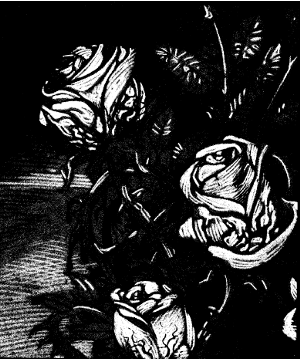

2153

| Climate/Terrain: | Ravenloft core domains |
|---|---|
| Frequency: | Uncommon |
| Organization: | Patch |
| Activity Cycle: | Any |
| Diet: | Blood |
| Intelligence: | Non- (0) |
| Treasure: | U |
| Alignment: | Nil |
| No. Appearing: | 3-36 (3d12) |
| Armor Class: | 10 |
| Movement: | 0 |
| Hit Dice: | 10 |
| THAC0: | 11 |
| No. of Attacks: | 1 |
| Damage/Attack: | 1d2 + target’s AC |
| Special Attacks: | Blood drain |
| Special Defenses: | Nil |
| Magic Resistance: | Nil |
| Size: | S (4’) |
| Morale: | N/A |
| XP Value: | 2,000 |
The bloodrose is a foul plant that feeds upon the blood of the living. Its keen thorns easily cut unprotected flesh, spilling precious blood into the soil where its roots can absorb it.
Bloodroses have dark green stems ending in flowers of purest white. Thin tendrils covered with sharp thorns hang limply from the base of the flower, looking much like the branches of a weeping willow. After feeding, the flowers begin to turn crimson with traces of blood etching their alabaster petals.
Bloodroses are unintelligent plants, unable to communicate in any way.
Combat: To someone not familiar with the bloodrose, the plant looks much like any other wild flower. Indeed, this illusion is the key to the plant’s feeding habits and is maintained until a wandering animal reaches the center of the patch. At that point, the plant suddenly springs to life. Without warning, the thorny tendrils lash out like whips, tearing into unprotected flesh and spilling life-giving blood on the earth below.
A bloodroot patch has a diameter in feet equal to the number of plants within it. Thus, a patch of 20 plants would be 20 feet wide. When an attack begins, each plant is entitled to one attack roll with a hit indicating that a number of damage points equal to the target’s Armor Class has been inflicted (with a minimum of 1 point). A patch of bloodroots is able to attack a number of mansized creatures equal to the number of plants that make it up.
Escaping the patch can be a difficult process. The whirling vines of these plants have the same effect as an entangle spell. The saving throw for this is modified by the number of plants above or below 10 in the patch. Thus, a patch with 13 plants imposes a -3 penalty on the save while a patch with 8 plants allows a +2 bonus.
If the patch is attacked as a whole it is assumed to have the total hit points of all its flowers. The same is true for determining its attack and saving throws. Thus, a patch of 10 plants attacks and saves as a 10-Hit-Die creature. If individual plants are targeted, they have only their own Hit Dice.
Blunt or piercing weapons cause but a single point of damage on a successful attack. Slashing weapons, fire, or other attack forms generally have their normal effect. Bloodroses are exceptionally vulnerable to salt water. Every gallon of salt water poured on a patch will cause 1d10 points of damage. Characters who coat themselves in salt will be attacked once. After that the plant recoils with pain and will not attack that individual again.
Habitat/Society: Bloodroses live in the high mountains or rocky badlands, places where most plant life is reduced to desperate weeds or tiny pockets. In these desolate areas the bloodroot thrives as local animals are forced to try their luck in eating them. Only creatures with the thickest of skins are successful, other hunters quickly become the hunted.
It is said that some creatures of the Demiplane of Dread actively cultivate the bloodroses in the high mountains to cover cave entrances and the like from prying adventurers.
Ecology: Bloodroses reproduce like most other plants, by pollen collecting insects that can approach the patch unmolested.
If a bloodrose can be collected while pure white, it is said to be able to ward off the attacks of certain types of undead, namely vampires. Bloodroses can only survive 1d4 days after being pulled from the vine. Even artificial feedings or replanting cannot help — the plant needs its patch to survive.

◆ 1440 ◆